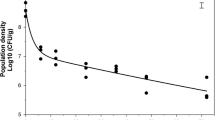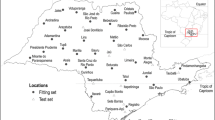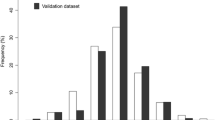Abstract
Leathery pocket (LP) and fruitlet core rot (FCR) of pineapple (Ananas comosus L.) caused by Penicillium funiculosum Thom. and/or Fusarium moniliforme Sheld cause significant damage in all production areas, resulting in a major economic impact that affects both the fresh fruit market and the processing sector. The detection of Penicillium and Fusarium in the two main areas of pineapple production in Reunion Island, and representing a large range of climatic conditions, indicated that these fungi responsible for FCR and LP diseases were present throughout the pineapple cycle, whatever the climatic conditions. The proportion of fruits naturally infected by these pathogens was not related to climatic conditions during the infection period, suggesting that the inoculum level was not limiting. As these diseases cannot be reliably controlled, due in particular to the role of climatic conditions, an important research goal is to predict periods of higher disease risk using a model based on weather data. Taking advantage of the great diversity of environments on the tropical island of Reunion (Indian Ocean), we were able to establish a link between a pluviothermic index (PTi: ratio between total rainfall and the average temperature over the fruit development stages), and LP or FCR incidence. Disease incidence was modelled as a function of the pluviothermic index via a Weibull model. The most accurate model was obtained during the open heart to harvest stage. Lastly, the model output can be used by pineapple production stakeholders in farm management strategies and to adapt fruit grading before marketing.



Similar content being viewed by others
References
Bartholomew, D. P., Malézieux, E., Sanewski, G. M., & Sinclair, E. (2003). Inflorescence and fruit development and yield. In D. P. Bartholomew, R. E. Paull, & K. G. Rohrbach (Eds.), The Pineapple: botany, production and uses (pp. 167–202). Wallingford: CABI publishing.
Bengozi, F. J., Sampaio, A. C., Spoto, M. H. F., Mischan, M. M., & Pallamin, M. L. (2007). Physico chemical quality of pineapple commercialized in the CEAGESP-Sao Paulo. Revista Brasileira de Fruticultura, 29, 540–543.
Bondalapati, K. D., Stein, J. M., Neate, S. M., Halley, S. H., Osborne, L. E., & Hollingsworth, C. R. (2011). Development of weather-based predictive models for fusarium head blight and deoxynivalenol accumulation for spring malting barley. Plant Disease, 96, 673–680.
Burnham, K. P., & Anderson, D. (2002). Model selection and multimodel interference (2nd ed.). New York: Springer.
Campbell, C. L., Jacobi, W. R., Powell, N. T., & Main, C. E. (1984). Analysis of disease progression and the randomness of occurrence of infected plants during tobacco black shank epidemics. Phytopathology, 74, 230–235.
Condés, S., & García-Robredo, F. (2012). An empirical mixed model to quantify climate influence on the growth of Pinus halepensis Mill. stands in South-Eastern Spain. Forest Ecology and Management, 284, 59–68.
de Matos, A. P. (1995). Pathological aspects of the pineapple crop with emphasis on the Fusariosis. Revista de la Facultad de Agronomía, 21, 179–197.
De Wolf, E. D., & Isard, S. A. (2007). Disease cycle approach to plant disease prediction. Annual Review of Phytopathology, 45, 203–220.
Del Ponte, E. M., Godoy, C. V., Li, X., & Yang, X. B. (2006). Predicting severity of asian soybean rust epidemics with empirical rainfall models. Phytopathology, 96, 797–803.
Development Core Team, R. (2011). A language and environment for statistical computing. ([verified 15 October 2012] ed.). Vienna: R Foundation for Statistical Computing.
Dobson, A. J., & Barnett, A. G. (2008). An introduction to generalized linear models. Third edition (texts in statistical science series). Boca Raton: Chapman & Hall / CRC Taylor & Francis Group.
Duthie, J. A. (1997). Models of the response of foliar parasites to the combined effects of temperature and duration of wetness. Phytopathology, 87, 1088–1095.
Efron, B. (1983). Estimating the error rate of a prediction rule: improvement on cross-validation. Journal of the American Statistical Association, 78, 316–331.
Emberger, L. (1955). Une classification biogéographique des climats. Naturalia Montpelica Sér. Botanique, 7, 3–43.
Fournier, P. (2011). La culture de l‘ananas victoria à la réunion pour l’exportation. France: Recueil de bonnes pratiques CIRAD.
Fournier, P., Dubois, C., Benneveau, A., & Soler, A. (2010). Growth indicators for different pineapple cultivars compared with the current standard smooth cayenne in west Africa and reunion island: a first step toward modeling growth. Agronomy Journal, 102, 1572–1577.
Ganry, J., de Lapeyre de Bellaire, L., & Mourichon, X. (2008). A biological forecasting system to control Sigatoka disease of bananas and plantains. Fruits, 63, 381–387
Gavilán, R. (2005). The use of climatic parameters and indices in vegetation distribution a case study in the spanish sistema central. International Journal of Biometeorology, 50, 111–120.
Gell, I., Cal, A., Torres, R., Usall, J., & Melgarejo, P. (2008). Relationship between the incidence of latent infections caused by Monilinia spp. And the incidence of brown rot of peach fruit: factors affecting latent infection. European Journal of Plant Pathology, 121, 487–498.
Ghanbarnia, K., Fernando, W. G. D., & Crow, G. (2009). Developing rainfall- and temperature-based models to describe infection of canola under field conditions caused by pycnidiospores of Leptosphaeria maculans. Phytopathology, 99, 879–886.
Gouache, D. (2005). Master’s thesis. INA P-G: France. Analyse de la variabilité des conditions d’apparition de la maladie des taches noires de l’ananas à La Réunion (et considérations sur la qualité).
Guerout, R. (1974). Les taches noires de l'ananas. Fruits, 29, 489–499.
Hartinee, A., Zabedah, M., & Malip, M. (2011). Effects of N and K on plant biomass, yield and quality of 'Maspine' pineapple fruit grown on Rasau soil. Acta Horticulturae, 902, 269–274.
Hepton, A., & Anderson, E. J. (1968). Interfruitlet corking of pineapple fruit, a new disease in Hawaï. Phytopathology, 58, 74–78.
Jacobs, A., Van Wyk, P. S., Marasas, W. F. O., Wingfield, B. D., Wingfield, M. J., & Coutinho, T. A. (2010). Fusarium ananatum sp. nov. in the Gibberella fujikuroi species complex from pineapples with fruit rot in South Africa. Fungal Biology, 114, 515–27.
Keetch, D. P. (1977). Diseases and pests. H1. Black spot (fruit core rot) in pineapples. In G. Printer (Ed.), Pineapple cultivation in South Africa. Pretoria: CSFRI.
Kobayashi, K., & Us Salam, M. (2000). Comparing simulated and measured values using squared deviation and its component. Agronomy Journal, 92, 345–352.
Konstantinou, S., Karaoglanidis, G. S., Bardas, G. A., Minas, I. S., Doukas, E., & Markoglou, A. N. (2011). Postharvest fruit rots of apple in Greece: Pathogen incidence and relationships between fruit quality parameters, cultivar susceptibility, and patulin production. Plant Disease, 95, 666–672.
Marie, F., Malezieux, E., Marchal, J., & Perrier, X. (2000). On farm approach of pineapple fruitlet core rot disease in Martinique. Acta Horticulturae, 529, 261–263.
Mourichon, X. (1983). Contribution à l’étude des taches noires (fruitlet core rot) et leathery pocket de l’ananas causés par Penicillium funiculosum THOM. en Côte d'Ivoire. Fruits, 38, 601–609.
Mourichon, X. (1991). Etude sur les maladies du fruit : Les taches noires et leathery pocket. Fruits, 46, 390–394.
Mourichon, X., Perrier, X., & Thibaud, B. (1987). Les taches noires (fruitlet core rot) et leathery pocket de l‘ananas en Côte d'Ivoire Recherche des principaux facteurs explicatifs. Fruits, 42, 343–352.
Petty, G. J., Tustin, H. A., & Dicks, H. M. (2006). Control of black spot disease/fruitlet core rot in queen pineapple with integrated mealybug, pineapple fruit mite and fungus control programmes. Acta Horticulturae, 702, 143–149.
Pitt, J. I., & Hocking, A. D. (2009). Fungi and food spoilage (3rd ed.). UK: Aspen Publishers, Inc.
Prusky, D. (1996). Pathogen quiescence in postharvest diseases. Annual Review of Phytopathology, 34, 413–434.
Py, C., Lacoeuille, J. J., & Teisson, C. (1984a). Affection des fruits liées à des Penicillium sp. et Fusarium sp. (fruitlet core rot, leathery pocket, interfruitlet corking). In L’ananas, sa culture, ses produits (pp. 199–204). France: Maisonneuve et Larose.
Py, C., Lacoeuille, J. J., & Teisson, C. (1984b). Eléments de taxonomie, origine, dispersion. In L’ananas, sa culture, ses produits (pp. 15–19). France: Maisonneuve & Larose.
Rohrbach, K. G. (1989). Unusual tropical fruit diseases with extended latent periods. Plant Disease, 73, 607–609.
Rohrbach, K. G., & Johnson, M. W. (2003). Pests, Diseases and Weeds. In D.P.Bartholomew, R. E. Paull, & K. G. Rohrbach (Eds.), The Pineapple: botany, production and uses (pp. 203–251). Wallingford, U.K.: CABI publishing
Rohrbach, K. G., & Pfeiffer, J. B. (1976a). Field induction of pineapple interfruitlet corking, leathery pocket, and fruitlet core rot with Penicillium funiculosum. Phytopathology, 66, 392–395.
Rohrbach, K. G., & Pfeiffer, J. B. (1976b). Susceptibility of pineapple cultivars to fruit diseases incited by Penicillium funiculosum and Fusarium moniliforme. Phytopathology, 66, 1386–1390.
Rohrbach, K. G., & Taniguchi, G. (1984). Effects of temperature, moisture, and stage of inflorescence development on infection of pineapple by Penicillium funiculosum and Fusarium moniliforme var. subglutinans. Phytopathology, 74, 995–1000.
Rohrbach, K. G., Namba, R., & Taniguchi, G. (1981). Endosulfan for control of pineapple interfruitlet corking, leathery pocket and fruitlet core rot. Phytopathology, 9, 1006.
Samson, R. A., Hoekstra, E. S., & Frisvad, J. C. (2004). Introduction to food borne fungi (7th ed.). Netherlands: Centraalbureau voor Schimmelcucutures.
Soler, A. (1992). Ananas: critères de qualité. France: CIRAD et COLEACP.
Teisson, C. (2002). Examen des nuisances sur ananas en Afrique de l’Ouest Rapport de mission. France: CIRAD.
Tryon, H. (1898). Fruitlet core rot of pineapple. Queensland agricultural journal, 3, 458–467.
van Maanen, A., & Xu, X. M. (2003). Modelling plant disease epidemics. European Journal of Plant Pathology, 109, 669–682.
Acknowledgements
Thanks to Marie Darnaudery, Bernard Abufera, and Georget Tullus for their essential contribution: they set up the fields, maintained them, and carried out the indispensable observations. The authors gratefully acknowledge C. Fovet-Rabot and P. Biggins for revising the manuscript and English editing.
Author information
Authors and Affiliations
Corresponding author
Rights and permissions
About this article
Cite this article
Fournier, P., Benneveau, A., Hardy, C. et al. A predictive model based on a pluviothermic index for leathery pocket and fruitlet core rot of pineapple cv. ‘Queen’. Eur J Plant Pathol 142, 449–460 (2015). https://doi.org/10.1007/s10658-015-0625-8
Accepted:
Published:
Issue Date:
DOI: https://doi.org/10.1007/s10658-015-0625-8




